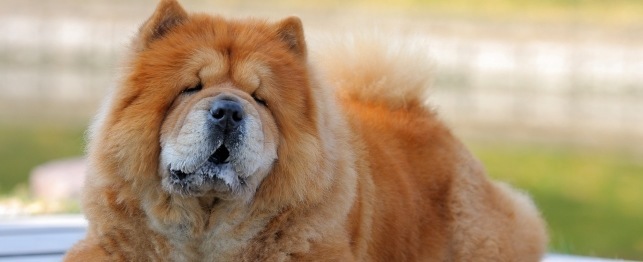

Dogs
The chow chow is a medium sized dog with an ancient lineage. Today, the breed is firmly established as a popular American dog. Originating in China, chow chows are well recognized for their fluffy appearance, black tongue and wrinkled face. Though very devoted to their family, chows are not overly friendly to strangers.
The chow chow, more commonly known as the chow, is considered one of the oldest recognized dog breeds in the world. The exact ancestral home is not known but the breed surely originates from Mongolia, Siberia or northern China. Based on extensive research, it is believed that the chow has been in existence since the Han dynasty of 150 B.C.
In addition to controversy surrounding the breeds' ancestral home, the translation of the word chow chow is also debated. There are currently two theories. One theory relates the name to the shipping industry. Ships traveling from the Far East to Europe had to describe their contents. Most ships carried a variety of items and to make it easier for the shippers, the term 'chow chow' or 'bric-a-brac' was used to describe them. When the dogs became part of the ship contents, the name stuck.
The other theory is not as well liked. Some feel that the name chow is a Cantonese/American slang word for food and refers to the breed's unfortunate use as a food item. Some people dispute that the chow was ever used for food and feel that there is some confusion between the chow and a similar appearing dog that really is used as a food source.
Even though the chow originated in northern China, most of the dogs were found in the Canton area of southern China where he was called the 'black mouthed dog' due to his uncommonly blue-black tongue. The breed was so popular that at least one kennel housed up to 5,000 dogs at one time.
The chow was first brought to England in the late 19th century and became popular after Queen Victoria showed an interest in the breed. After finally arriving in the United States in early 1900, the chow was quickly accepted into the American Kennel Club in 1903 as a member of the non-sporting group.
The chow chow is a muscular medium-haired dog with a stocky build. The dog has a large head with a broad flat skull, short muzzle and facial wrinkles that result in a perpetual scowl. The ears are upright, rounded and small. The tail curls and is carried high over the back. The best known attribute of the dog is the blue black tongue, which is a rarity among dogs.
The chow has a double hair coat with a dense outer coat and a soft woolly undercoat. The most common colors are red, black and cinnamon.
The chow measures 19 to 22 inches from the ground to the top of the shoulder. The average weight of an adult chow is 45 to 55 pounds.
The chow is known for having a strong personality and will of iron and does not appreciate too much attention. The chow is aloof and sedentary with a not-completely-deserved reputation of being aggressive. Unfortunately, a small number of improperly bred and poorly socialized chows have maligned the reputation of the breed. For this reason, chows are often misunderstood and mistrusted by many.
As a member of the family, the chow is loving and devoted, but this does not extend to strangers. Due to his protective nature, the chow can be unfriendly or even aggressive toward people they do not know. He prefers to be the only dog in the house and frequently develops a strong bond with one family member. The chow is not a good choice for families with small children since the breed is not too tolerant of children's antics.
The chow is a strong-willed aloof dog that can be difficult to train for obedience but can be successfully trained as a guard dog. The breed is a natural and effective watchdog.
Due to the thick double hair coat, frequent grooming is necessary to prevent tangling and matting of the hair. Care must be taken around strangers and small children unfamiliar to the dog.
The lifespan of the chow chow is 9 to 11 years.
We realize that each dog is unique and may display other characteristics. This profile provides generally accepted breed information only.
Copyright © 2005-2016 Pet Information All Rights Reserved
Contact us: www162date@outlook.com